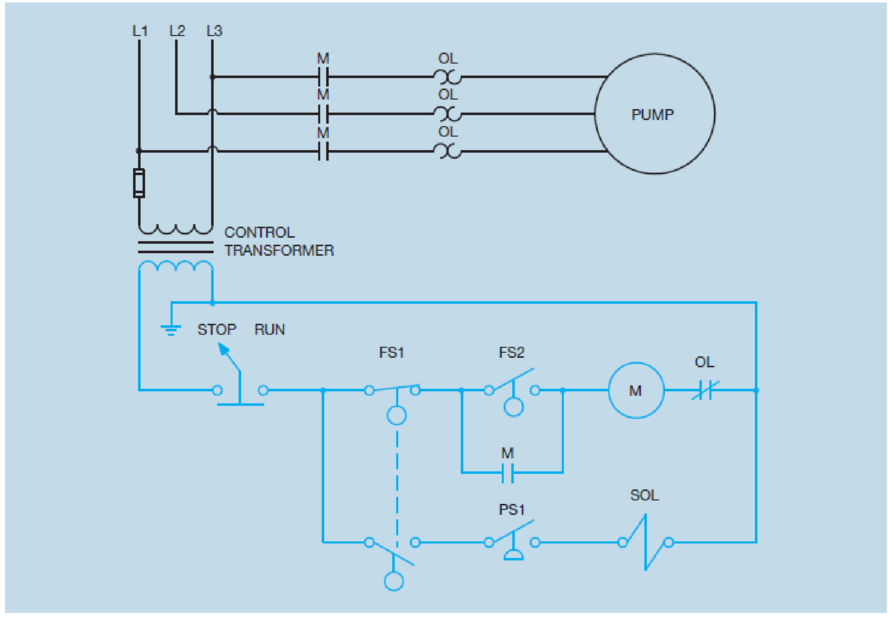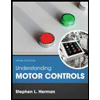
Understanding Motor Controls
4th Edition
ISBN: 9781337798686
Author: Stephen L. Herman
Publisher: Delmar Cengage Learning
expand_more
expand_more
format_list_bulleted
Concept explainers
Textbook Question
Chapter 22, Problem 6RQ
Refer to the circuit shown in Figure 22–1. Should float switch FS2 be wired as normally open or normally closed? Explain your answer.

Figure 22–1 Pump control circuit.
Expert Solution & Answer
Want to see the full answer?
Check out a sample textbook solution
Students have asked these similar questions
I need to adapt a real-life system to this assignment. It doesn't need to be a very complicated system.
I am a senior mechanical engineering student. I need help with my mechanical theory homework
state all the formulae associated with adiabatic process
Design a Moore type synchronous state machine with three external inputs A1, A2, A3 and
one output signal F. The output F goes to 1 when A1.A2.-A3 = 1 at the next system timing
event. The output F stays at 1 as long as A3=0; otherwise, the output goes to 0. (Note: use
a positive edge-triggered D flip-flop in the design)
Write a VHDL code to describe the implementation of one-digit decimal counter using
PROCESS.
Chapter 22 Solutions
Understanding Motor Controls
Ch. 22 - Prob. 1RQCh. 22 - When connecting a control system, what should be...Ch. 22 - What should be done to each component to help...Ch. 22 - What is the disadvantage of wiring components to a...Ch. 22 - What is the main advantage of making connections...Ch. 22 - Refer to the circuit shown in Figure 221. Should...Ch. 22 - What does the dashed line between the two float...
Knowledge Booster
Learn more about
Need a deep-dive on the concept behind this application? Look no further. Learn more about this topic, mechanical-engineering and related others by exploring similar questions and additional content below.Similar questions
- State all the formulae associated with the Isothermal Process.arrow_forward: +0 العنوان solle не Am 4 A pump draws water through a 300-mm diameter cast iron pipe, 15m long from a reservoir in which the water surface is 4.5 m higher than the pump and discharges through a 250- mm diameter cast iron, 75 m long, to an elevated tank in which the water surface is 60 m higher than the pump. Q=0.25 m³/s. Considering f-0.02 and the coefficients for minor head losses (k entrance 0.5, k bend 0.35, and K exit -0.5), compute the power of the pump. ۳/۱ ۲/۱ 4.5 m Kentrance 300 mm dia. 15 m Length 250 mm dia. 75 m Length kpend kexit 60 m ostlararrow_forwardA 100 m length of a smooth horizontal pipe is attached to a large reservoir. A attached to the end of the pipe to pump water into the reservoir at a volume flow rate of 0.01 m³/s. What pressure (gage) must the pump produce at the pipe to generate this flow rate? The inside diameter of the smooth pipe is 150mm. Dynamic Viscosity of water is 1*103 Kg/(m.s). K at the exit of the pipe is 1. pump 10 m D=150mm L= 100 m- Pumparrow_forward
- : +0 العنوان solle не A 4 A numn drawe water through 200 ۳/۱ ۲/۱ A heavy car plunges into a lake during an accident and lands at the bottom of the lake on its wheels as shown in figure. The door is 1.2 m high and 1 m wide, and the top edge of the door is 8 m below the free surface of the water. Determine the hydrostatic force on the door if it is located at the center of the door, and discuss if the driver can open the door, if not; suggest a way for him to open it. Assume a strong person can lift 100 kg, the passenger cabin is well-sealed so that no water leaks inside. The door can be approximated as a vertical rectangular plate. 8 m E ✓ Lakearrow_forwardTwo concentric plain helical springs of the same length are wound out of the samewire circular in cross section and supports a compressive load P. The inner springmean diameter 200 mm. Calculate the maximum stress induced in the spring if theconsists of 20 turns of mean dimeter 160 mm and the outer spring has 18 turns ofdiameter of wire is equal to 10 mm and Pis equal to 1000 N. (Take Ks=1)arrow_forwardt 1+2\xi pu +962гz P 1 A heavy car plunges into a lake during an accident and lands at the bottom of the lake on its wheels as shown in figure. The door is 1.2 m high and I m wide, and the top edge of the door is 8 m below the free surface of the water. Determine the hydrostatic force on the door if it is located at the center of the door, and discuss if the driver can open the door, if not; suggest a way for him to open it. Assume a strong person can lift 100 kg, the passenger cabin is well-sealed so that no water leaks inside. The door can be approximated as a vertical rectangular plate. 加 8 m 1.2 m Lake -20125 DI 750 x2.01 5 P 165 Xarrow_forward
- 11. If Sin(x+α) = 2Cos(x-a); prove that: tan x= 2- tana 1-2 tanaarrow_forward12. If Sin(x-a)= Cos(x+α); prove that: tan x=1.arrow_forward: +0 العنوان solle не A 4 A numn drawe water through 200 ۳/۱ ۲/۱ A heavy car plunges into a lake during an accident and lands at the bottom of the lake on its wheels as shown in figure. The door is 1.2 m high and 1 m wide, and the top edge of the door is 8 m below the free surface of the water. Determine the hydrostatic force on the door if it is located at the center of the door, and discuss if the driver can open the door, if not; suggest a way for him to open it. Assume a strong person can lift 100 kg, the passenger cabin is well-sealed so that no water leaks inside. The door can be approximated as a vertical rectangular plate. 8 m E ✓ Lakearrow_forward
- ۲/۱ - | العنوان A heavy car plunges into a lake during an accident and lands at the bottom of the lake on its wheels as shown in figure. The door 1.2 m high and 1 m wide, and the top edge of the door is 8 m below the free surface of the water. Determine the hydrostatic force on the door if it is located at the center of the door, and discuss if the driver can open the door, if not; suggest a way for him to open it. Assume a strong person can lift 100 kg, the passenger cabin is well-sealed so that no water leaks inside. The door can be approximated as a vertical rectangular plate. 8 m Lakearrow_forward- | A pump draws water through a 300-mm diameter cast iron pipe, 15m long from a reservoir in which the water surface is 4.5 m higher than the pump and discharges through a 250- mm diameter cast iron, 75 m long, to an elevated tank in which the water surface is 60 m higher than the pump. Q-0.25 m³/s. Considering f- 0.02 and the coefficients for minor head losses (k entrance 0.5, k bend 0.35, and K exit -0.5), compute the power of the pump. Kexit 250 mm dia 75 m Length 60 m العنوان 300 mm dia. 15 m Length -UZ kentrance 11421 Kpend osthor oster ۲/۱arrow_forwardA heavy car plunges into a lake during an accident and lands at the bottom of the lake on its wheels as shown in figure. The door is 1.2 m high and 1 m wide, and the top edge of the door is 8 m below the free surface of the water. Determine the hydrostatic force on the door if it is located at the center of the door, and discuss if the driver can open the door, if not; suggest a way for him to open it. Assume a strong person can lift 100 kg, the passenger cabin is well-sealed so that no water leaks inside. The door can be approximated as a vertical rectangular plate. 8 m m Lakearrow_forward
arrow_back_ios
SEE MORE QUESTIONS
arrow_forward_ios
Recommended textbooks for you
 Understanding Motor ControlsMechanical EngineeringISBN:9781337798686Author:Stephen L. HermanPublisher:Delmar Cengage Learning
Understanding Motor ControlsMechanical EngineeringISBN:9781337798686Author:Stephen L. HermanPublisher:Delmar Cengage Learning Refrigeration and Air Conditioning Technology (Mi...Mechanical EngineeringISBN:9781305578296Author:John Tomczyk, Eugene Silberstein, Bill Whitman, Bill JohnsonPublisher:Cengage Learning
Refrigeration and Air Conditioning Technology (Mi...Mechanical EngineeringISBN:9781305578296Author:John Tomczyk, Eugene Silberstein, Bill Whitman, Bill JohnsonPublisher:Cengage Learning Understanding Motor ControlsMechanical EngineeringISBN:9781305498129Author:Stephen L. HermanPublisher:Cengage Learning
Understanding Motor ControlsMechanical EngineeringISBN:9781305498129Author:Stephen L. HermanPublisher:Cengage Learning Electrical Transformers and Rotating MachinesMechanical EngineeringISBN:9781305494817Author:Stephen L. HermanPublisher:Cengage Learning
Electrical Transformers and Rotating MachinesMechanical EngineeringISBN:9781305494817Author:Stephen L. HermanPublisher:Cengage Learning

Understanding Motor Controls
Mechanical Engineering
ISBN:9781337798686
Author:Stephen L. Herman
Publisher:Delmar Cengage Learning

Refrigeration and Air Conditioning Technology (Mi...
Mechanical Engineering
ISBN:9781305578296
Author:John Tomczyk, Eugene Silberstein, Bill Whitman, Bill Johnson
Publisher:Cengage Learning

Understanding Motor Controls
Mechanical Engineering
ISBN:9781305498129
Author:Stephen L. Herman
Publisher:Cengage Learning

Electrical Transformers and Rotating Machines
Mechanical Engineering
ISBN:9781305494817
Author:Stephen L. Herman
Publisher:Cengage Learning
Fluid Mechanics - Viscosity and Shear Strain Rate in 9 Minutes!; Author: Less Boring Lectures;https://www.youtube.com/watch?v=_0aaRDAdPTY;License: Standard youtube license